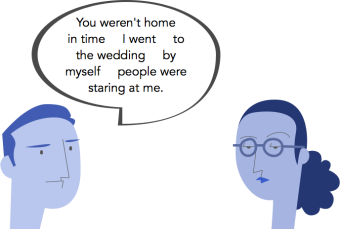Apparently, this is a Great Mystery of Grammar, as so many people get it wrong. I had a client a while back who complained about my run-on sentences in marketing copy. I looked and looked, thinking maybe I had committed a grammatical gaffe and had actually written a run-on sentence, a pet peeve. But no, time and time again the sentence structure was fine. Subject, verb, etc., all in their proper places. I didn’t know what he was talking about. Then it hit me one day. He thought the sentences were too long. Oh! That’s different.
 So as a public service, let me explain a run-on sentence. A run-on has absolutely nothing to do with how long it is. You can write very short run-on sentences. And you can write really long sentences — ones that take up an entire paragraph and drag on and on, seemingly forever, until you’re not even sure what they say anymore — that aren’t run-ons.
So as a public service, let me explain a run-on sentence. A run-on has absolutely nothing to do with how long it is. You can write very short run-on sentences. And you can write really long sentences — ones that take up an entire paragraph and drag on and on, seemingly forever, until you’re not even sure what they say anymore — that aren’t run-ons.
The term “run-on” sounds like it should refer to any sentence that runs on too long. I understand the confusion; it makes logical sense. But the number of words in a sentence has nothing to do with whether it’s a run-on.
The key to a run-on is that it contains incorrect punctuation and is missing a conjunction between two independent clauses.
Wait! Come back! Don’t give up yet! I realize I just lost some of you. Hang in there. It gets better. (Not: Hang in there, it gets better. That would be a run-on sentence.)
What the heck is an independent clause? Let me ‘splain…
An independent clause is a phrase that contains both a subject and a verb. That last sentence is an independent clause. Sentences are independent clauses.
“So why aren’t they just called sentences? Why fancy things up with another term that means the very same thing?” Well, while sentences are independent clauses, not all independent clauses are sentences that live by themselves. Sometimes they have roommates. For example, I can say “Tom jumped over the fence, but Mary went through the gate.” Each of the phrases before and after the “, but” is an independent clause, and the two independent clauses are joined by a comma and conjunction to form a complete sentence. (Notice I just did it again.)
If I were to write it “Tom jumped over the fence, Mary went through the gate” that would be a run-on sentence because there is no conjunction, no bridge between the independent clauses. Without the conjunction, the comma would need to magically transform to either a period or a semicolon. This is also referred to a comma splice, an equally egregious offense to the grammar gods.
To demonstrate that run-on sentences have nothing to do with length, consider this example: “Tom jumped, Mary ran.” Now that’s a short run-on! But it fits the bill: two subjects, two verbs, no conjunction, and the wrong punctuation.
Reporters are the worst at this. Often they will write a quote from a sports star, for example, as “We played hard today, that was the key to victory.” Wrong! While playing hard may very well have contributed to the team coming out on top, grammatically those are two separate things and need to either be joined by a comma and conjunction (likely not the best option, since you don’t want to add to what someone said) or separated by a period and capital letter or a semicolon instead of the comma. Joining those two independent clauses with just a comma is incorrect. (And should require a blood sacrifice.)
Now, if you want to see the doozy of all run-on sentences and feel better about yourself because even the best authors in the world can write them, check out the opening pages of A Tale of Two Cities, considered by many to be the longest run-on sentence in literary history. It was the best of run-on sentences, it was the worst of run-on sentences. (Cringe!) Of course, Charles Dickens got paid by the word, so maybe we’ll cut him some slack. You, however, are not.
So mind your commas and conjunctions and don’t go running off at the sentence!

Your explanation of a run-on sentence is excellent. I’m going to use it with my fourth graders.